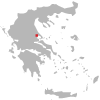Dimini
Dimini (Δίμηνι), is a Neolithic settlement in central Greece, near the Mesolithic settlement of Sesclo, and west of the modern city of Volos, in Thessaly, Greece.
The excavations on the low hill revealed an extensive stone age settlement that was originally much closer to the west shore of Pagasitikos Gulf. The site was inhabited continuously from late Neolithic period (4800-4500 BCE) in mud brick houses built over foundations made of local stone, all enclosed in a roughly circular external low wall which was also made of local slate stone.
The complexity of the building construction, town planning, and the unearthed artifacts denote a thriving and sophisticated stone age community. The function of the perimeter wall as defensive has been questioned, but the existence of several large communal buildings atop the hill is evidence of a well organized community with a rich social culture.
The existence of the perimeter walls and the separation of the houses have prompted speculation that social divisions led to segregation of different families within the settlement. The existence of a central court and the large "Megaron" structure in the middle of the village indicates a certain cooperative hierarchy and social division unseen in previous eras. In any case, the emphasis on privacy is a new development in Middle Neolithic settlements like Dimini.
Walls separate the houses, which have doors opening into public space, and cooking took place inside (as opposed to the previous custom of cooking in an outdoor area besides the houses). A ceramic kiln was excavated in the settlement and several graves.
The settlement remained in use until the final Neolithic period, and even into the beginnings of the Bronze Age. Subsequently, it was abandoned for a brief period of time only to re-emerge as a thriving Mycenaean center which developed east of Neolithic Dimini. Despite extensive plotting, the Mycenaean settlement has not been excavated beyond the unearthing of two impressive Tholos tombs. There has been speculation that this is the location of ancient Iolkos itself - the famous departure port of Jason and the Argonauts.
Photo Gallery


 The large "Megaron" house dominates the crest of the low hill, at the center of the enclosed settlement. Its layout has been interpreted to be a place of Neolithic worship since it resembles the general plan of the later Greek and Roman temples.
The large "Megaron" house dominates the crest of the low hill, at the center of the enclosed settlement. Its layout has been interpreted to be a place of Neolithic worship since it resembles the general plan of the later Greek and Roman temples.



-



-
 These standing stones are interpreted to be an attempt to separate a private space - a form of primitive fence -, and as evidence of the elevated sense of privacy exhibited in the middle Neolithic period.
These standing stones are interpreted to be an attempt to separate a private space - a form of primitive fence -, and as evidence of the elevated sense of privacy exhibited in the middle Neolithic period. -
 House "N" is the largest excavated house of the settlement. Its typical neolithic beaten clay floor, hearths, and storage areas, are protected today by a tin roof today.
House "N" is the largest excavated house of the settlement. Its typical neolithic beaten clay floor, hearths, and storage areas, are protected today by a tin roof today. -
 The kiln at Dimini.
The kiln at Dimini.  Covered upright stone slabs provided underground drainage for the village.
Covered upright stone slabs provided underground drainage for the village.
 Aerial view of the excavations (left) and reconstruction of the Neolithic settlement at Dimini. Both images provide ample context for the archaeological site visitors.
Aerial view of the excavations (left) and reconstruction of the Neolithic settlement at Dimini. Both images provide ample context for the archaeological site visitors.

 The Mycenaean tholos tomb is found to the west of the Neolithic settlement, and it denotes an important Bronze Age center.
The Mycenaean tholos tomb is found to the west of the Neolithic settlement, and it denotes an important Bronze Age center.


 Artifacts excavated from Dimini on exhibition in the National Archaeological Museum of Athens.
Artifacts excavated from Dimini on exhibition in the National Archaeological Museum of Athens. In the Middle Bronze Age, the hills around Sesclo and Dimini were used as cemeteries. 19 graves were found in Dimini. These are some of the artifacts from various graves that are exhibited at the Volos Museum.
In the Middle Bronze Age, the hills around Sesclo and Dimini were used as cemeteries. 19 graves were found in Dimini. These are some of the artifacts from various graves that are exhibited at the Volos Museum.
 The Tholos Tomb "Lamiospito" is located about 300m. away from Dimini on the way to Sesclo. It is a Late Helladic (LH III A) structure, dating to the 14th c. BCE. The dromos ends in the majestic entrance with the characteristic relieving triangle of stones above it. Access to the tomb is restricted but a reconstruction and a written description make the visit to the site worthwhile.
The Tholos Tomb "Lamiospito" is located about 300m. away from Dimini on the way to Sesclo. It is a Late Helladic (LH III A) structure, dating to the 14th c. BCE. The dromos ends in the majestic entrance with the characteristic relieving triangle of stones above it. Access to the tomb is restricted but a reconstruction and a written description make the visit to the site worthwhile.


